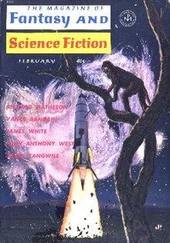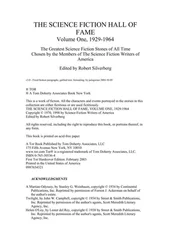Robert Silverberg - The Asenion Solution
Здесь есть возможность читать онлайн «Robert Silverberg - The Asenion Solution» весь текст электронной книги совершенно бесплатно (целиком полную версию без сокращений). В некоторых случаях можно слушать аудио, скачать через торрент в формате fb2 и присутствует краткое содержание. Год выпуска: 2014, ISBN: 2014, Издательство: Subterranean Press, Жанр: Фантастика и фэнтези, на английском языке. Описание произведения, (предисловие) а так же отзывы посетителей доступны на портале библиотеки ЛибКат.
- Название:The Asenion Solution
- Автор:
- Издательство:Subterranean Press
- Жанр:
- Год:2014
- ISBN:978-1-59606-693-9
- Рейтинг книги:5 / 5. Голосов: 1
-
Избранное:Добавить в избранное
- Отзывы:
-
Ваша оценка:
- 100
- 1
- 2
- 3
- 4
- 5
The Asenion Solution: краткое содержание, описание и аннотация
Предлагаем к чтению аннотацию, описание, краткое содержание или предисловие (зависит от того, что написал сам автор книги «The Asenion Solution»). Если вы не нашли необходимую информацию о книге — напишите в комментариях, мы постараемся отыскать её.
The Asenion Solution — читать онлайн бесплатно полную книгу (весь текст) целиком
Ниже представлен текст книги, разбитый по страницам. Система сохранения места последней прочитанной страницы, позволяет с удобством читать онлайн бесплатно книгу «The Asenion Solution», без необходимости каждый раз заново искать на чём Вы остановились. Поставьте закладку, и сможете в любой момент перейти на страницу, на которой закончили чтение.
Интервал:
Закладка:
The Asenion Solution
by Robert Silverberg
Fletcher stared bleakly at the small mounds of gray metal that were visible behind the thick window of the storage chamber.
“Plutonium-186,” he muttered. “Nonsense! Absolute nonsense!”
“Dangerous nonsense, Lew” said Jesse Hammond, standing behind him. “Catastrophic nonsense.”
Fletcher nodded. The very phrase, “plutonium-186,” sounded like gibberish to him. There wasn’t supposed to be any such substance. Plutonium-186 was an impossible isotope, too light by a good fifty neutrons. Or a bad fifty neutrons, considering the risks the stuff was creating as it piled up here and there around the world. But the fact that it was theoretically impossible for plutonium-186 to exist did not change the other, and uglier, fact that he was looking at three kilograms of it right this minute. Or that as the quantity of plutonium-186 in the world continued to increase, so did the chance of an uncontrollable nuclear reaction leading to an atomic holocaust.
“Look at the morning reports,” Fletcher said, waving a sheaf of faxprints at Hammond. “Thirteen grams more turned up at the nucleonics lab of Accra University. Fifty grams in Geneva. Twenty milligrams in—well, that little doesn’t matter. But Chicago, Jesse, Chicago—three hundred grams in a single chunk!”
“Christmas presents from the Devil,” Hammond muttered.
“Not the Devil, no. Just decent serious-minded scientific folk who happen to live in another universe where plutonium-186 is not only possible but also perfectly harmless. And who are so fascinated by the idea that we’re fascinated by it that they keep on shipping the stuff to us in wholesale lots! What are we going to do with it all, Jesse? What in God’s name are we going to do with it all?”
Raymond Nikolaus looked up from his desk at the far side of the room.
“Wrap it up in shiny red-and-green paper and ship it right back to them?” he suggested.
Fletcher laughed hollowly. “Very funny, Raymond. Very very funny.”
He began to pace the room. In the silence the clicking of his shoes against the flagstone floor seemed to him like the ticking of a detonating device, growing louder, louder, louder…
He—they, all of them—had been wrestling with the problem all year, with an increasing sense of futility. The plutonium-186 had begun mysteriously to appear in laboratories all over the world—wherever supplies of one of the two elements with equivalent atomic weights existed. Gram for gram, atom for atom, the matching elements disappeared just as mysteriously: equal quantities of tungsten-186 or osmium-186.
Where was the tungsten and osmium going? Where was the plutonium coming from? Above all, how was it possible for a plutonium isotope whose atoms had only 92 neutrons in its nucleus to exist even for a fraction of a fraction of an instant? Plutonium was one of the heavier chemical elements, with a whopping 94 protons in the nucleus of each of its atoms. The closest thing to a stable isotope of plutonium was plutonium-244, in which 150 neutrons held those 94 protons together; and even at that, plutonium-244 had an inevitable habit of breaking down in radioactive decay, with a half-life of some 76 million years. Atoms of plutonium-186, if they could exist at all, would come dramatically apart in very much less than one 76-millionth of a second.
But the stuff that was turning up in the chemistry labs to replace the tungsten-186 and the osmium-186 had an atomic number of 94, no question about that. And element 94 was plutonium. That couldn’t be disputed either. The defining characteristic of plutonium was the presence of 94 protons in its nucleus. If that was the count, plutonium was what that element had to be.
This impossibly light isotope of plutonium, this plutonium-186, had another impossible characteristic about it: not only was it stable, it was so completely stable that it wasn’t even radioactive. It just sat there, looking exceedingly unmysterious, not even deigning to emit a smidgeon of energy. At least, not when first tested. But a second test revealed positron emission, which a third baffled look confirmed. The trouble was that the third measurement showed an even higher level of radioactivity than the second one. The fourth was higher than the third. And so on and so on.
Nobody had ever heard of any element, of whatever atomic number or weight, that started off stable and then began to demonstrate a steadily increasing intensity of radioactivity. No one knew what was likely to happen, either, if the process continued unchecked, but the possibilities seemed pretty explosive. The best suggestion anyone had was to turn it to powder and mix it with nonradioactive tungsten. That worked for a little while, until the tungsten turned radioactive too. After that graphite was used, with somewhat better results, to damp down the strange element’s output of energy. There were no explosions. But more and more plutonium-186 kept arriving.
The only explanation that made any sense—and it did not make very much sense—was that it was coming from some unknown and perhaps even unknowable place, some sort of parallel universe, where the laws of nature were different and the binding forces of the atom were so much more powerful that plutonium-186 could be a stable isotope.
Why they were sending odd lumps of plutonium-186 here was something that no one could begin to guess. An even more important question was how they could be made to stop doing it. The radioactive breakdown of the plutonium-186 would eventually transform it into ordinary osmium or tungsten, but the twenty positrons that each plutonium nucleus emitted in the course of that process encountered and annihilated an equal number of electrons. Our universe could afford to lose twenty electrons here and there, no doubt. It could probably afford to go on losing electrons at a constant rate for an astonishingly long time without noticing much difference. But sooner or later the shift toward an overall positive charge that this electron loss created would create grave and perhaps incalculable problems of symmetry and energy conservation. Would the equilibrium of the universe break down? Would nuclear interactions begin to intensify? Would the stars—even the Sun—erupt into supernovas?
“This can’t go on,” Fletcher said gloomily.
Hammond gave him a sour look. “So? We’ve been saying that for six months now.”
“It’s time to do something. They keep shipping us more and more and more, and we don’t have any idea how to go about telling them to cut it out.”
“We don’t even have any idea whether they really exist,” Raymond Niklaus put in.
“Right now that doesn’t matter. What matters is that the stuff is arriving constantly, and the more of it we have, the more dangerous it is. We don’t have the foggiest idea of how to shut off the shipments. So we’ve got to find some way to get rid of it as it comes in.”
“And what do you have in mind, pray tell?” Hammond asked.
Fletcher said, glaring at his colleague in a way that conveyed the fact that he would brook no opposition, “I’m going to talk to Asenion.”
Hammond guffawed. “Asenion? You’re crazy!”
“No. He is. But he’s the only person who can help us.”
It was a sad case, the Asenion story, poignant and almost incomprehensible. One of the finest minds atomic physics had ever known, a man to rank with Rutherford, Bohr, Heisenberg, Fermi, Meitner. A Harvard degree at twelve, his doctorate from M.I.T. five years later, after which he had poured forth a dazzling flow of technical papers that probed the deepest mysteries of the nuclear binding forces. As the twenty-first century entered its closing decades he had seemed poised to solve once and for all the eternal riddles of the universe. And then, at the age of 28, without having given the slightest warning, he walked away from the whole thing.
Читать дальшеИнтервал:
Закладка:
Похожие книги на «The Asenion Solution»
Представляем Вашему вниманию похожие книги на «The Asenion Solution» списком для выбора. Мы отобрали схожую по названию и смыслу литературу в надежде предоставить читателям больше вариантов отыскать новые, интересные, ещё непрочитанные произведения.
Обсуждение, отзывы о книге «The Asenion Solution» и просто собственные мнения читателей. Оставьте ваши комментарии, напишите, что Вы думаете о произведении, его смысле или главных героях. Укажите что конкретно понравилось, а что нет, и почему Вы так считаете.












